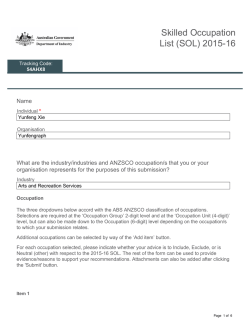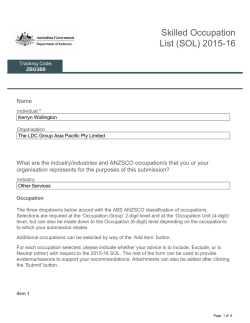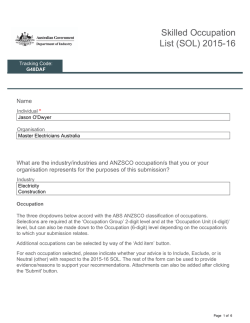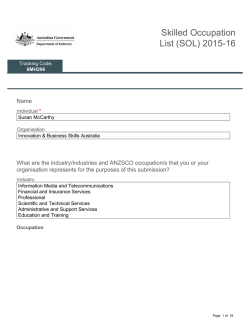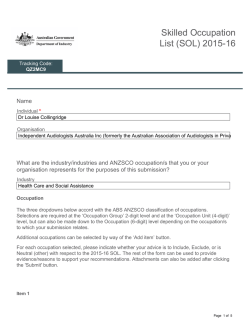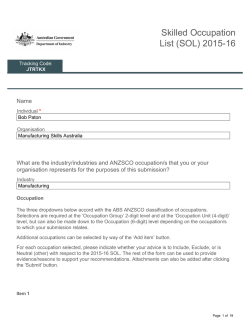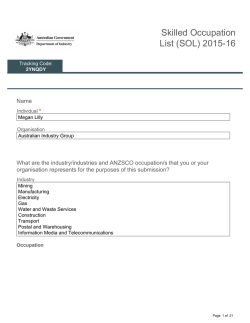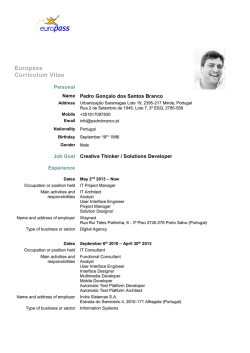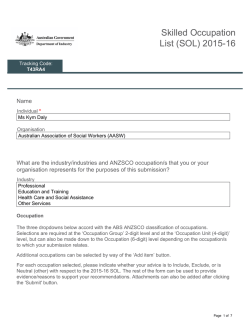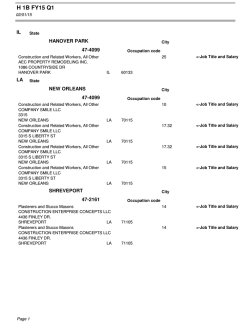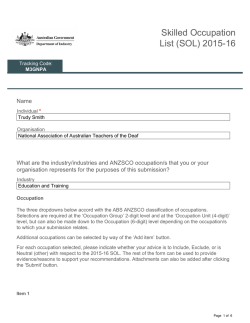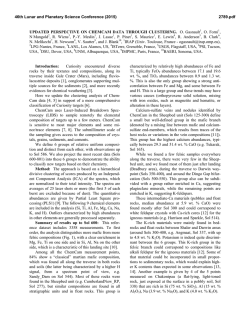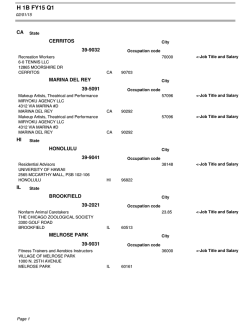
Skilled Occupation List (SOL) 2015-16
Skilled Occupation List (SOL) 2015-16 Tracking Code: 24AKG5 Name Individual * Jocelyne Aldridge Organisation Community Services and Health Industry Skills Council (CS&HISC) What are the industry/industries and ANZSCO occupation/s that you or your organisation represents for the purposes of this submission? Industry Health Care and Social Assistance Occupation The three dropdowns below accord with the ABS ANZSCO classification of occupations. Selections are required at the ‘Occupation Group’ 2-digit level and at the ‘Occupation Unit (4-digit)’ level, but can also be made down to the Occupation (6-digit) level depending on the occupation/s to which your submission relates. Additional occupations can be selected by way of the ‘Add item’ button. For each occupation selected, please indicate whether your advice is to Include, Exclude, or is Neutral (other) with respect to the 2015-16 SOL. The rest of the form can be used to provide evidence/reasons to support your recommendations. Attachments can also be added after clicking the 'Submit' button. Item 1 Page 1 of 16 Occupation Group * Specialist Managers Occupation Unit * Health and Welfare Services Managers Occupation All Summary advice for 2015-16 SOL * Include Exclude Neutral Item 2 Occupation Group * Specialist Managers Occupation Unit * Child Care Centre Managers Occupation Child Care Centre Manager 134111 Summary advice for 2015-16 SOL * Include Exclude Neutral Item 3 Occupation Group * Health Professionals Occupation Unit * Midwives Occupation Midwife 254111 Page 2 of 16 Summary advice for 2015-16 SOL * Include Exclude Neutral Exclude Neutral Exclude Neutral Item 4 Occupation Group * Health Professionals Occupation Unit * Registered Nurses Occupation All Summary advice for 2015-16 SOL * Include Item 5 Occupation Group * Carers and Aides Occupation Unit * Child Carers Occupation All Summary advice for 2015-16 SOL * Include Item 6 Page 3 of 16 Occupation Group * Carers and Aides Occupation Unit * Aged and Disabled Carers Occupation Aged or Disabled Carer 423111 Summary advice for 2015-16 SOL * Include Exclude Neutral Item 7 Occupation Group * Carers and Aides Occupation Unit * Nursing Support and Personal Care Workers Occupation Nursing Support Worker 423312 Summary advice for 2015-16 SOL * Include Exclude Neutral Item 8 Occupation Group * Carers and Aides Occupation Unit * Nursing Support and Personal Care Workers Occupation Personal Care Assistant 423313 Page 4 of 16 Summary advice for 2015-16 SOL * Include Exclude Neutral Item 9 Occupation Group * Carers and Aides Occupation Unit * Nursing Support and Personal Care Workers Occupation Therapy Aide 423314 Summary advice for 2015-16 SOL * Include Exclude Neutral Exclude Neutral Item 10 Occupation Group * Carers and Aides Occupation Unit * Education Aides Occupation All Summary advice for 2015-16 SOL * Include Item 11 Page 5 of 16 Occupation Group * Health and Welfare Support Workers Occupation Unit * Enrolled and Mothercraft Nurses Occupation All Summary advice for 2015-16 SOL * Include Exclude Neutral Item 12 Occupation Group * Health and Welfare Support Workers Occupation Unit * Indigenous Health Workers Occupation Aboriginal and Torres Strait Islander Health Worker 411511 Summary advice for 2015-16 SOL * Include Exclude Neutral Item 13 Occupation Group * Health and Welfare Support Workers Occupation Unit * Welfare Support Workers Occupation All Page 6 of 16 Summary advice for 2015-16 SOL * Include Exclude Neutral Item 14 Occupation Group * Other Clerical and Administrative Workers Occupation Unit * Other Miscellaneous Clerical and Administrative Workers Occupation Clinical Coder 599915 Summary advice for 2015-16 SOL * Include Exclude Neutral Item 15 Occupation Group * Business, Human Resource and Marketing Professionals Occupation Unit * Archivists, Curators and Records Managers Occupation Health Information Manager 224213 Summary advice for 2015-16 SOL * Include Exclude Neutral Page 7 of 16 Are there any occupations that you represent where there is evidence of imbalances in the demand for and supply of skills in the medium-to-long term? * The latest government data and feedback CS&HISC has received from industry employers, indicate occupational shortages and recruitment difficulties in the following eight areas. 1. Support workers in health, community and home settings In 2012 government reported that demand had outstripped supply resulting in a national shortage of aged care workers, disability support workers (ANZSCO 4321 – Aged and Disabled Carers) and Nursing Support Workers (ANZSCO 423312). More recent reports from the Department of Employment indicate that these occupations and similar personal care roles are no longer in shortage. However, feedback received by CS&HISC from employers indicates ongoing difficulties recruiting suitably qualified people to roles aligned with ANZSCO 4321 – Aged and Disabled Carers; ANZSCO 423312 - Nursing Support Workers and ANZSCO 423313 - Personal Care Assistants. Recent feedback suggests that increased and changing demand for services, coupled with an ageing workforce and the physical demands of the job are contributing to difficulties recruiting a sufficient number of appropriately qualified workers in these roles. This feedback is reported in our annual Environmental Scan , the next edition is due to be released in April 2015. 2. Assistants in Healthcare Providers of community services and health have also reported difficulties recruiting to health assistant roles such as Allied Health Assistants (ANZSCO 423314 – Therapy Aide). Aboriginal and Torres Strait Islander health workers (ANZSCO 411511) were identified as an occupational group in shortage by 12 organisations with national or State/ Territory coverage in written submissions to CS&HISC’s 2014 Environmental Scan. 3. Child Carers In its most recent report on skill shortages the Department of Employment reported a national and persistent shortage of qualified child care workers (ANZSCO 421111). Difficulties recruiting suitably qualified child care workers were also noted in the 2014 Environmental Scan. 4. Health and Community Service Managers The 2014 Community Services and Health industry Environmental Scan identified that the strong demand for managers in the context of service expansion and evolving models of service delivery. Service providers continue to report difficulties recruiting suitably qualified managers across the industry (ANZSCO 1342 and 134111). 5. Health professionals in fields allied to medicine In its most recent report on skill shortages the Department of Employment reported a national and persistent shortage of Physiotherapists (ANZSCO 252511). 6. Health scientists and technicians In its most recent report on skill shortages the Department of Employment reported a national Page 8 of 16 and persistent shortage of Sonographers (ANZSCO 251214). 7. Nurses and midwives In its most recent report on skill shortages the Department of Employment reported a national and persistent shortage of midwifery professionals (ANZSCO 254111). The 2014 Environmental Scan also highlighted difficulties recruiting both registered (2544) and enrolled nurses (411411). More recent stakeholder feedback indicated that the distribution of qualified nurses may not be meeting service and client needs. While there is anecdotal evidence of an oversupply of registered nurse graduates in some areas, feedback from stakeholders suggests that specific service areas such as Aged Care struggle to find the numbers of appropriately qualified nurses they need. Difficulties recruiting nurses in regional, rural and remote areas have also been reported. 8. Health and community service administration managers and assistants In their submissions to the 2014 Environmental Scan, the departments of health in both Victoria and New South Wales identified a shortage of the administrative and information staff required to support best-practice implementation. Specifically, clinical coders (entry, mid and supervisory levels), clinical costing officers and clinical coding auditors (all aligned to ANZSCO 599915); and health information managers (224213). Is there evidence of imbalances in the demand for and supply of skills in the medium-to-long term in non-metropolitan areas? If so, can you indicate in what part of Australia and the number in the occupation in over or undersupply. Difficulties recruiting and retaining health and community services workers in rural and remote areas are well documented. These difficulties relate to the nature of rural and remote services which differ from those in metropolitan areas; the National Strategic Framework for Rural and Remote Health describes rural and remote health services as: ‘… more dependent on primary health care services, particularly those provided by General Practitioners (GPs). Facilities are generally smaller, provide a broad range of services (including community and aged care), have less infrastructure and locally available specialist services, and provide services to a more dispersed population.’ In terms of specific occupational shortages, it can be reasoned that national shortages are likely to be even more acute in rural and remote areas. Due to their location, services in more rural and remote environments may also experience difficulties recruiting to occupations not in shortage elsewhere. In addition, there is likely to be a greater need for preventative primary care roles with a broad skill base and the ability to refer, when appropriate, to more specialist staff and services. This will include workers in lower paid roles with lower qualification requirements. It will be important for Page 9 of 16 the Department to consider this when developing and applying the Skilled Occupation List (SOL) to workforce policy. 1. Nurses and midwives As previously mentioned, feedback from stakeholders suggests that certain regions, particularly regional, rural and remote areas struggle to find the numbers of appropriately qualified nurses they need. This is in addition to difficulties recruiting to specific service areas such as Aged Care. 2. Assistants in healthcare and support workers in health, community and home settings As noted above, in rural and remote areas there is likely to be a greater need for preventative primary care roles with a broad skill base and the ability to refer to more specialist roles and services. This means that difficulties recruiting assistants in health care and support workers in health, community and home settings will be particularly evident in regional, rural and remote areas. This includes roles in a range of occupational groups including: ANZSCO 423314 – Therapy Aides; ANZSCO 4321 – Aged and Disabled Carers; ANZSCO 423312 - Nursing Support Workers and ANZSCO 423313 - Personal Care Assistants. Are there any occupations which require formal licensing or registration arrangements in order to practice/perform in this occupation? For example: • Midwives are required to register with the nurses board in their state or territory • Panelbeaters are required to be registered or certified with the state Motor Vehicle Repair Industry Authority In developing the Australian Government’s Skilled Occupation List (SOL) Australian Workforce it will be important to consult with all the relevant registration bodies, regulators and professional associations in the Community Services and Health industry. Given the nature of their work many community services and health workers, particularly those working in the health professions, are subject to registration and are required to comply with associated standards in education, continued professional development, English language and a criminal records check. Following the Council of Australian Governments (COAG) decision in 2008 to establish a single National Registration and Accreditation Scheme (National Scheme) for health practitioners, the registration of health practitioners is moving from a state responsibility to a national one. The Australian Health Practitioner Regulation Agency (AHPRA) is the organisation responsible for the implementation of the National Registration and Accreditation Scheme across Australia. On 1 July 2010 (18 October for Western Australia), the following professions and occupations became nationally regulated by a corresponding National Board: • Chiropractors Page 10 of 16 • Dental practitioners (including dentists, dental hygienists, dental prosthetists & dental therapists) • Medical practitioners • Nurses and midwives (including enrolled and mothercraft nurses) • Optometrists • Osteopaths • Pharmacists • Physiotherapists • Podiatrists • Psychologists On July 2012, four additional professions joined the National Scheme: • Aboriginal and Torres Strait Islander health practitioners • Chinese medicine practitioners (including acupuncturists, Chinese herbal medicine practitioners and Chinese herbal dispensers) • Medical radiation practitioners (including diagnostic radiographers, radiation therapists and nuclear medicine technologists), and • Occupational therapists This leaves a large number of occupations in the ‘unregistered’ category. However, in addition to the standards set by individual employers, at a state level there are ‘code of conduct’ or ‘core skills’ policies for unregistered health practitioners in: • New South Wales: http://www.sahealth.sa.gov.au/wps/wcm/connect/Public+Content/SA +Health+Internet/Clinical+resources/Safety+and+quality/Governance+for+Safety+and+Quality +in+health+service+organisations/Credentialling/Unregistered+Health+Practitioners+Code+of +Conduct • South Australia: http://www.health.nsw.gov.au/phact/Documents/ Code_of_Conduct_unregistered_health_practitioners_-_poster_-_2012_Regulation.pdf • Victoria: http://www.health.vic.gov.au/workforce/learning/competencies.htm Furthermore, at the Standing Council on Health (SCoH) meeting of 14 June 2013, Ministers considered the final report of the national consultation, titled Decision Regulatory Impact Assessment: Options for regulation of unregistered health practitioners. Ministers agreed in principle to strengthen state and territory health complaints mechanisms via: • a single national Code of Conduct for unregistered health practitioners to be made by regulation in each state and territory, and statutory powers to enforce the Code by investigating breaches and issuing prohibition orders • a nationally accessible web based register of prohibition orders • mutual recognition of state and territory issued prohibition orders. An independent review of the National Registration and Accreditation Scheme for Health Practitioners has since been announced. Assistants in healthcare, health technicians and healthcare support worker make up a significant part of the current healthcare workforce. These occupational groups are expected to grow in the short and medium term. As they do it is likely that more formal requirements and registration will be considered for particular roles such as allied health assistants (AHAs) and assistants in nursing (AINs). Page 11 of 16 Outside of health, social workers and other community service practitioners are not subject to registration of licensing. However in its role as a professional association the Australian Association of Social Workers provides professional recognition of social work qualifications and produces a ‘code of conduct’ for social work: http://www.aasw.asn.au/practitioner-resources/ related-documents. In Children’s Services the Australian Children’s Education and Care Quality Authority (ACECQA) sets the minimum education standards for workers in long day care, family day care, preschool/ kindergarten, and outside school hours care: http://www.acecqa.gov.au/educators-andproviders1/qualifications. Financial Counselling Australia (FCA) is in the process of developing a national set of professional standards for Financial Counsellors. The job title ‘Financial Counsellor’ is already protected in law and these standards will help to define the skills required to operate as a Financial Counsellor. This work may also support the eventual establishment of a national register of financial counsellors. More information on what the FCA has done in this area is in their last annual review: http://www.financialcounsellingaustralia.org.au/getattachment/ Corporate/News/FCA-Releases-2012-13-Annual-Report/FCA-Annual-Report-2012-13-Final.pdf Is it expected that your employment sector will be impacted by any medium-to-long term trends which will impact upon demand and/or supply (excluding costs associated with training, labour hire, and international sponsorship)? Please provide evidence (e.g. data source, policy document) which substantiates these claims. For example: • New benchmarks for childcare centres mandate increased staff-to-child ratios and higher qualification standards for childcare workers. The Community Services and Health industry is the largest and fastest growing employer; recent data indicate that the industry employs approximately 1.4 million workers, 12 per cent of Australia’s workforce. Our industry is currently experiencing unprecedented change due to increased demand for services, changing nature of service demand, new models of service delivery and an increased emphasis on productivity. These changes are informed by demographic factors and policy drivers. Demographic factors Demand for community services and health is increasing due to changes in Australia’s demography. For example key demographic factors are Australia’s: • ageing population: by 2026 18.7% of population will be over 65 years and 2.4% aged over 85 years • co-morbidity: increasingly clients have multiple needs and require support from a range of services/ sectors e.g. 50% of people over 65 have at least one disability Page 12 of 16 • record birth rates: recent data indicate 300,000 births in Australia annually (the rate at height of the baby boom was 240,000). Policy drivers and new models of service delivery The models for delivering health and community services are shifting in response to changes in client needs and policy. For example: • more services delivered in the home and community • some services are moving to individualised funding models • reduced growth in government expenditure is fuelling an increased emphasis on productivity. Workforce implications These changes have notable implications for the health and community services workforce, some of which are already evident. Key implications for the health and community services workforce in general include: • increased demand for community services and health workers recent projections indicate that our industry will need between 24% (339,300) to 57% (798,800) more workers by 2025 • workforce models will need to support productive as well as quality services • existing roles will need to be re-orientated and new roles developed, including more workers with a broader base of knowledge and skills to support appropriate referral to specialist staff and services • increased demand on training providers, particularly in Vocational Education and Training (VET) to develop appropriately trained workers • professionalisation of non-professional roles with introduction of minimum education standards and registration in some areas. Looking at these changes in more detail, there are a number of occupational groups for which these changes will be particularly evident: assistants in healthcare, support workers in health community and home settings as well as managers across community services and health. In addition, changes in the regulation of early childhood education and care are impacting on demand for skilled workers in that sector. These changes are discussed in more detail below. 1. Assistants in healthcare and support workers in health, community and home settings As previously mentioned demand for community services and health is increasing and service models are evolving. Government policies, such as Living Longer Living Better and the National Disability Insurance Scheme are being rolled out. These policies, coupled with the broader policy and population drivers mean that we will need more workers with a broader base of knowledge and skills, working in multidisciplinary teams that support quality and productive services. These changes in service delivery models and services demand are most likely to impact the numbers and skills required of assistants in healthcare and support workers in health, community and home settings. Specifically it is anticipated that between 2013 and 2018 we will need: • 40,900 additional aged care workers and disability support workers (ANZSCO 4321 – Aged and Disabled Carers) • 13,500 additional nursing support and personal care workers (ANZSCO 4233) • 10,800 additional welfare support workers (ANZSCO 4117). This is supported by feedback from stakeholders CS&HISC has received which indicates that Page 13 of 16 employers are already experiencing difficulties recruiting to these roles, and a range of other roles in the Aged Care and Disability sectors including nurses, allied health professionals and allied health assistants. In addition, feedback from stakeholders in the Aged Care and Disability sectors also indicates an emerging need for workers with specialist skills and knowledge related to dementia and or mental health more broadly. There are no ANZSCO classifications that align to these roles, however it is expected that they would have a specific mental health qualification such as the Certificate IV in Mental Health which is aligned to ANZSCO 4321 – Aged and Disabled Carers. 2. Health and community service managers The leadership of adequately skilled and effective managers will be essential as community services and health organisations respond to the significant reforms in child care, aged care and disability support as well as health, care and support services more broadly. This will affect those roles aligned within the health and welfare service managers grouping (ANZSCO 1342) and child care centre managers (ANZSCO 134111). It is anticipated that we between 2013 and 2018 we will need an additional 4,500 health and welfare service managers. 3. Child carers and education aides An increasing number of children are accessing early childhood education and care services each year, raising the demand for early childhood workers. At the same time, child care reforms under the National Quality Framework (NQF) are already impacting the childcare and early childhood development workforce. The National Quality Framework (NQF) is the result of an agreement between all Australian governments to work together to provide better educational and developmental outcomes for children using long day care, family day care, preschool/kindergarten, and outside school hours care. The National Quality Standard (NQS) is a key aspect of the NQF. The NQS consists of seven quality areas, each containing standards and elements, that children's education and care services are assessed and rated against. Every long day care, family day care, preschool/kindergarten, and outside school hours service is expected to maintain a specific ratio of Certificate III, Diploma and Degree qualified staff based on the number of children and their ages. These changes are driving increased demand for child carers (ANZSCO 4211) and education aides (ANZSCO 4221). Between 2013 and 2018 it is expected that Australia will need: • 21,600 additional child carers • 15,100 additional education aides. Although training numbers for child carers and education aides are also increasing, strong employment growth and anecdotal evidence of workers leaving the sector suggest shortages are likely to persist for child care workers over the next few years. Page 14 of 16 Please provide any other information you consider relevant evidence to support your submission For example, you may know of some independent studies about your occupation that supports your advice to us. Australian Government Department of Education Employment and Workplace Relations (2012). Skills Shortage Report: Personal Care Workers. November 2012. Community Services and Health Industry Skills Council (2014). Environmental Scan: Agenda for Change. Australian Government Department of Employment (2014). Skill Shortages Australia 2013-14. Australian Government, Standing Council on Health (2011). National Strategic Framework for Rural and Remote Health. Canberra: Commonwealth of Australia Australian Workforce Productivity Agency (2013), Future focus, 2013 National Workforce Development Strategy. Australian Government Department of Employment (2014). Occupational Projections to 2018. Australian Government Department of Education, Employment and Workplace Relations (2013). Skill Shortages Australia 2012-13, Canberra. Would you like to make any additional comments on the SOL? Please provide the name, position and contact details of a person within your organisation who is willing to be contacted if any further information or follow-up is required. Name * Dr Brendan Goodger Position * Research and Policy Manager Page 15 of 16 Contact details * [email protected]; [email protected] 02 8226 6632 All information, including name and address details, contained in submissions will be made available to the public on the Department of Industry website unless you indicate that you would like all or part of your submission to remain in confidence. Automatically generated confidentiality statements in emails do not suffice for this purpose. Respondents who would like all or part of their submission to remain in confidence should provide this information in an email to SOL@industry. gov.au . Legal requirements, such as those imposed by the Freedom of Information Act 1982, may affect the confidentiality of your submission. Page 16 of 16
© Copyright 2025
